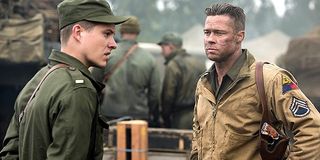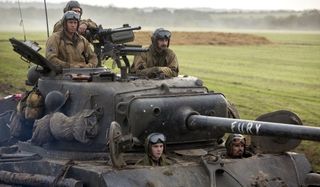Why Making A Tank Movie Sucks, According To The Director Of Fury

"Welcome to my nightmare."
This is how Fury director David Ayer jokingly reacts to my initial question about filming an entire World War II drama involving tanks. Anyone who has ever watched a car chase scene in an action movie has to comprehend how difficult it can be to make automobiles move the way that you want them to for a given sequence. With Fury (in theaters today), Ayer asks Brad Pitt, Logan Lerman, Shia LaBeouf and the men of the tank platoon to shoulder the load of shooting with lumbering beasts as co-stars. And the way he describes it, it sounds like pure hell.
David Ayer is known for gritty, realistic dramas that focus on slices of life in impossible situations. End of Watch explained to outsiders what it feels like to live and work as a police officer. And Fury puts audiences in the belly of a tank, marching – slowly – into battle with equally massive tanks that could blow you out of the water with a precise cannon shot.
"Now I know why there are not more tank movies," Ayer admits, explaining that his team had 70-year-old antiques to work with. "They’re dangerous. They’re loud. It’s really hard to communicate." The director tells us that they actually developed a radio system so that the director could communicate with tank drivers ("who are basically blind as they drive") and the tank commanders, who are the eyes and ears of safety for the tanks, themselves.

There are a lot of moving parts, according to Ayer, just to get one shot. And there’s one other complication that audience members might not even realize. When you place Brad Pitt in a tank, he’s automatically 13-feet high. It requires cranes and special equipment just to be able to photograph that high. Also, it’s mobile. Tanks are always moving, so David Ayer had to figure out how to attach cameras on cranes to moving vehicles just to keep up with his human stars AND their military, mechanical co-stars – the tanks.
The process taught Ayer how to let go, how to settle with slightly less than perfection, and to capture the moment, then move on to the next shot. He tells us:
It was a vast headache. If somebody does the wrong thing, it’s like an oil tanker. It takes a long time to turn it around once it’s moving. … The whole story of being a director is that nothing is ever exactly the way that you want it. It’s a constant exercise in frustration and self-loathing. [Laughs]"
Was Fury worth the effort? David Ayer might have had to compromise on certain scenes, but he admits that it is a "beautiful movie" filled with little victories. He’s content that the found the "story of every shot," but admits that he can be "maddeningly meticulous" about choices made on screen. He admits the body count for Fury is "significant," but that the loss of life was a point of the movie. And he says that he made this movie for military veterans, and he hopes that they get something special out of Fury screenings.
CINEMABLEND NEWSLETTER
Your Daily Blend of Entertainment News
I heard that cops show End of Watch to spouses to say, ‘This is what I go through each day.’ I’d love to capture that same resonance with the armed forces [with this movie]."
Fury opens in theaters today.

Sean O’Connell is a journalist and CinemaBlend’s Managing Editor. Having been with the site since 2011, Sean interviewed myriad directors, actors and producers, and created ReelBlend, which he proudly cohosts with Jake Hamilton and Kevin McCarthy. And he's the author of RELEASE THE SNYDER CUT, the Spider-Man history book WITH GREAT POWER, and an upcoming book about Bruce Willis.
Most Popular




